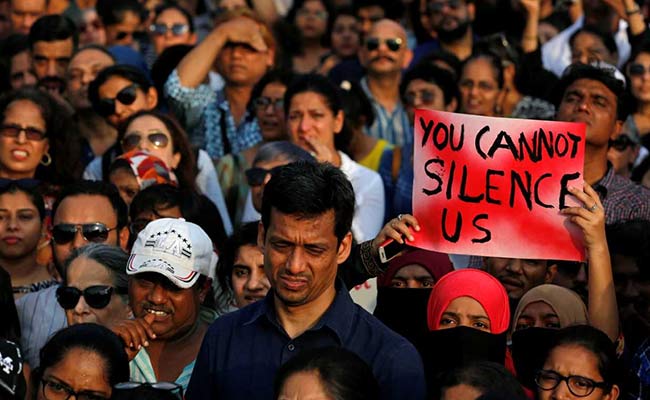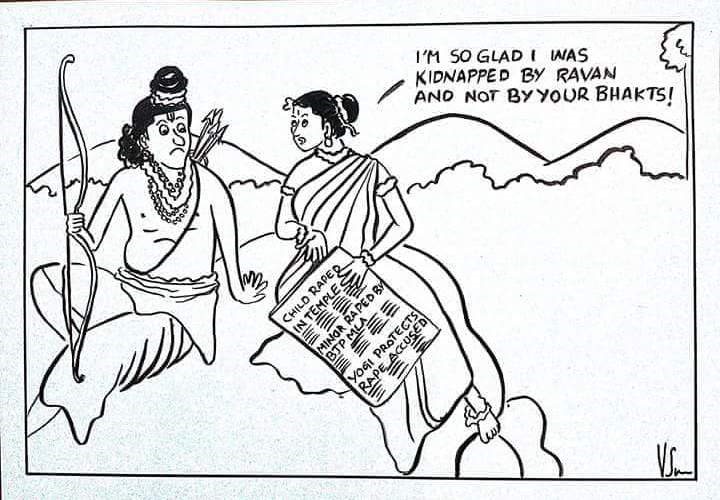The price of freedom
April 19, 2018 | Expert Insights

Swathi Vadlamudi, a journalist who recently published a cartoon protesting the Kathua and Unnao rape cases, has been getting multiple death threats on social media. The cartoon is political and criticises Hindu extremists while depicting Hindu Gods.
In addition, a case has been filed against the journalist for hurting the sentiments of Hindus in India.
Background
In January 2018, an eight-year-old girl, called Asifa Bano went missing in Kathua. She had disappeared for a week before villagers spotted her body. It emerged that she had been abducted and repeatedly raped through that period before being killed. She belonged to the Bakarwal Muslim tribe. Protests across India erupted in April 2018 as the details of the case became public. The incident has been covered internationally focusing on safety on women in India and communal violence.
During this period, another rape case has also become national news. In the Unnao case, a BJP MLA from Uttar Pradesh, Kuldeep Singh Sengar, has been accused of raping a teenager in June 2017. The teenager tried committing suicide in front of the politician’s house later.
Freedom of press in India
According to the 2017 World Press Freedom Index compiled by Reporters Without Borders (RSF), India ranks 136 and has become the third most dangerous country for journalists. Over the last 16 months, 54 journalists have been subject to attacks and the saddening part is the pattern of impunity. Out of 114 incidents of attacks on journalists in 2014, only 32 were taken into consideration and were arrested. In September 2017, Gauri Lankesh was a prominent journalist and writer, who lived in Bangalore, Karnataka was found brutally murdered. She had been a staunch critic of right-wing propaganda and Hindu nationalism. In 2015, M. M. Kalburgi, an India scholar and a rationalist, was murdered in his residence by two unidentified men. At the time, many believed it was due to his beliefs in rationalism. Narendra Dabholkar, anti-superstition advocate and a rationalist, was also murdered in 2013.
Another non-governmental organization called the Committee to Protect Journalists, has also ranked India as a country that is unsafe for journalists. According the organization’s research, at least 27 journalists have been murdered because of their work in India since 1992.

Analysis
Swathi Vadlamudi is a journalist and a cartoonist, who published a politically and religiously tinged cartoon on Facebook. The cartoon depicts a fictional conversation between two Indian gods, Lord Ram and Sita. In the piece, Sita comments on the Kathua rape case. She “tells” Lord Ram that she is “glad” that she was kidnapped by Ravan (the mythical antagonist of Ramayana) than “bhakts”.
The cartoon upon publishing, quickly became viral across social media. It was both widely praised and incurred criticism from those following the Hindu religion as well. Critics argued that the cartoon exists to hurt the sentiments of Hindus across India. In addition to the criticism, Vadlamudi has also begun getting multiple threats online. Some of these threats include death threats as well.
Vadlamudi for her part has noted that these threats have only made her “stronger”. During an interview with BBC, stated, “I can't sleep at night because of the threats on social media," she said, adding that her family was concerned over her safety.” She has been threatened with a Charlie Hebdo style attack (an attack that occurred in France against journalists working for the Charlie Hebdo newspaper for having depicted a likeness of Prophet Muhammed).
In addition to the death threats she has received on social media, a group has also filed as case against her. Hyderabad-based Hindu Sanghatan's president and advocate Kashimshetty Karuna Sagar has filed an FIR against Vadlamudi for "hurting the sentiments of Hindus". This FIR has been criticised and condemned by women's groups in India as well as the Indian Journalists Union (IJU).
Counterpoint
Section 295A states that “deliberate and malicious acts, intended to outrage religious feelings or any class by insulting its religion or religious beliefs” is an offense punishable by law.
Assessment
Our assessment is that journalist must be sensitive to drawing cartoons that might offend religious sensitivities. Whether drawing such cartoons constitute press freedom is debatable. While freedom of press and the right to debate is a pre-requisite for a democracy, we would advocate restraint as it may now further vitiate the social fabric of the country.
Read more: Justice for Asifa








Comments